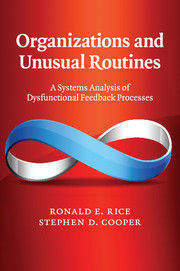Book contents
- Frontmatter
- Contents
- List of figures
- List of tables
- List of boxes
- Preface
- Acknowledgments
- 1 Crazy systems, Kafka circuits, and unusual routines
- 2 Causes, symptoms, and subroutines of unusual routines in six computer information/communication systems
- 3 Getting personal: unusual routines at the customer service interface
- 4 A multi-theoretical foundation for understanding unusual routines
- 5 A detailed case study of unusual routines
- 6 Summary and discussion of the case study results
- 7 Individual and organizational challenges to feedback
- 8 A multi-level and cross-disciplinary summary of concepts related to unusual routines
- 9 Recommendations for resolving and mitigating unusual routines and related phenomena
- 10 Summary and a tentative integrated model of unusual routines
- References
- Index
4 - A multi-theoretical foundation for understanding unusual routines
Published online by Cambridge University Press: 10 January 2011
- Frontmatter
- Contents
- List of figures
- List of tables
- List of boxes
- Preface
- Acknowledgments
- 1 Crazy systems, Kafka circuits, and unusual routines
- 2 Causes, symptoms, and subroutines of unusual routines in six computer information/communication systems
- 3 Getting personal: unusual routines at the customer service interface
- 4 A multi-theoretical foundation for understanding unusual routines
- 5 A detailed case study of unusual routines
- 6 Summary and discussion of the case study results
- 7 Individual and organizational challenges to feedback
- 8 A multi-level and cross-disciplinary summary of concepts related to unusual routines
- 9 Recommendations for resolving and mitigating unusual routines and related phenomena
- 10 Summary and a tentative integrated model of unusual routines
- References
- Index
Summary
Chapters 1 through 3 have provided a good basis for identifying, describing, and, to some small extent, explaining unusual routines. So far the analysis has primarily applied extensions of Singer's crazy systems perspective. However, both the phenomenon and the explanations are much more complex and subtle, and require the application of multiple theories, primarily from organizational and communication research.
The purpose of this chapter, then, is to further elaborate the conceptualization of URs, with the ultimate goal of developing it as an analytic tool and diagnostic. The first section summarizes five central theoretical approaches that form the basis for the case analysis in the following two chapters – systems theory, sensemaking theory, diffusion of innovation theory, socio-technical systems theory, and, especially relevant to our topic, organizational routines theory. The next section outlines a working model of URs with levels of analysis. The concluding section presents five general propositions about the creation of and change in URs, which the case study in Chapter 5 explores.
Five foundational theories for a preliminary model of unusual routines
Systems theory
Systems theory is not really a single theory, but several approaches with related sets of principles. Of relevance to our discussion of URs is general systems theory, social/open systems theory, and cybernetic systems theory.
- Type
- Chapter
- Information
- Organizations and Unusual RoutinesA Systems Analysis of Dysfunctional Feedback Processes, pp. 107 - 154Publisher: Cambridge University PressPrint publication year: 2010



